Papers by Satish Chandra Sati
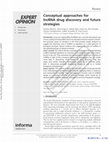
Expert Opinion on Drug Discovery, 2012
Introduction: Long non-coding RNAs (lncRNAs) are a recently discovered class of non-coding functi... more Introduction: Long non-coding RNAs (lncRNAs) are a recently discovered class of non-coding functional RNA which has attracted immense research interest. The growing corpus of literature in the field provides ample evidence to suggest the important role of lncRNAs as regulators in a wide spectrum of biological processes. Recent evidence also suggests the role of lncRNAs in the pathophysiology of disease processes. Areas covered: The authors discuss a conceptual framework for understanding lncRNA-mediated regulation as a function of its interaction with other biomolecules in the cell. They summarize the mechanisms of the known functions of lncRNAs in light of this conceptual framework, and suggest how this insight could help in discovering novel targets for drug discovery. They also argue how certain emerging technologies could be of immense utility, both in discovering potential therapeutic targets as well as in further therapeutic development. Expert opinion: The authors propose how the field could immensely benefit from methodologies and technologies from six emerging fields in molecular and computational biology. They also suggest a futuristic area of lncRNAs design as a potential offshoot of synthetic biology, which would be an attractive field, both for discovery of targets as well as a therapeutic strategy.
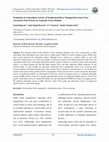
Journal of Mountain Research, 2021
The substance which avoids oxidant of easily oxidizing substance even at low concentration is cal... more The substance which avoids oxidant of easily oxidizing substance even at low concentration is called antioxidant when antioxidant reacts with reactive oxygen species (ROS) or reactive nitrogen species (RNS) they often convert themself into antioxidant radical. Although such a radical has a reduced ability to react with imperative cellular targets, it can still cause damage. To decrease reactivity and reduction potential further down, the ‘antioxidant radical' react with another antioxidant and this reaction continues in a stepwise manner until antioxidant radical’ is no longer damage the cells like lipids, protein, DNA, and other important cellular molecules. In this research article, we had scanned our previously synthesized silver nanoparticles from Citrus aurantium peels extracts; Synthesis and characterization part of the research work is already in communication we are extending our research work on previously synthesized silver nanoparticles. In this research article, we h...
The aim of the study is to find out the insecticidal assay of Salix babylonica and Triumfetta pil... more The aim of the study is to find out the insecticidal assay of Salix babylonica and Triumfetta pillosa. The ethanolic extract was concentrated to give a residue that was used as its insecticidal activity against mustard aphid Lipaphis erysimi. A total of forty insects were tested in each treatment with four replications. In each replication, ten insects were kept in a petri plate sized 6 inch with mustard leaf and then plant extract was sprayed with chromatographic sprayer. After 6, 12 and 24 hours of spraying, observations were recorded for the number of dead insects (insect mortality).
The antimicrobial activity of the all extracts of Senecio chrysanthemoides were studied against f... more The antimicrobial activity of the all extracts of Senecio chrysanthemoides were studied against five (gram negative and gram positive bacteria) and three fungal stain. The results showed that the minimum inhibitory concentration (MIC) of Senecio chrysanthemoides extract was 50μg/ml against Salmonella entericatypm. The ethye acetate extract of Senecio chrysanthemoides showed significant activity 19±1mm, 17±1mm and 13±1mm against E. coli, Salmonella entericatypm and Klebsiella pneumonia, against food poisoning bacteria and the order of the species based on total antibacterial activity is as follows: Escherichia coli ˃ Salmonella entericatypm ˃ Klebsiella pneumonia and phytochemical screening for the presence of glycosides, alkaloids, phenols and tannins.
Journal of the Indian Chemical Society, 2021
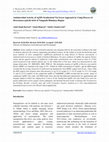
Journal of Mountain Research, 2021
Green synthesis of nano structured materials isan emerging field for the researchers working in t... more Green synthesis of nano structured materials isan emerging field for the researchers working in the field of chemical, physical, life sciences, engineering and medical sciences, for the welfare of society.In the present study green synthesis of silver nanoparticles (AgNPs)was performed by using flowers of Bistorta macrophylla, a medicinal herb of polygonaceae family of Garhwal Himalayas. For green synthesis of AgNPs, the aqueous flowers extract and the aqueous solution of AgNO3(of 5 milli molar concentration) were well mixed in ratios of 1:9.The metal ion present in the solution reduced Ag+1 to Ag0 within three to four days, which was characterized by color change observation, UV, SEM-EDX, XRD, TEM etc. The absorption maxima of AgNPs of Bistorta macrophylla flowers (BMF) was obtained in the range of 451– 454nm for 5mM concentration of AgNO3, and the SEM images revealed that the average clustersize of synthesized Ag nanoparticles from 5BMF1:9ranges from 20 μm– 23μm, while the EDX ana...
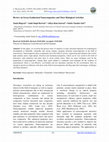
Journal of Mountain Research, 2021
In this paper, we reviewed the present status of synthesis of nano structured materials for techn... more In this paper, we reviewed the present status of synthesis of nano structured materials for technological development as bimetallic, trimetallic and various organic, inorganic polymers nanocomposites in the field of nanosciences. Nanocomposites play an important role in the field of sciences, engineering and industries due to their high catalytic power, high optical, electrical and mechanical properties, which can be very useful in the field of biosensors, nano medicines and many more as social welfare factor. There are many techniques used for the preparation of nanocomposites. Among them, green method is commonly used technique for the synthesis of nanomaterials which is cost-effective, eco-friendly and less hazardous materials for the environment. Here we attempt to present an elaborate work done in the field of nanocomposites dwelling upon their advantages, challenges and future prospects.
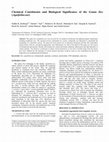
The Natural Products Journale, 2012
The genus Ilex (Aquifoliaceae) was reviewed for its chemical constituents and pharmacological sig... more The genus Ilex (Aquifoliaceae) was reviewed for its chemical constituents and pharmacological significance including traditional uses. The structure-activity relationship for various compounds was illustrated to understand the mechanism of a particular activity. The genus has been known for its numerous biological activities like antioxidant, antimicrobial, cytotoxic, anti-platelet aggregation, anti-inflammatory etc. Most of the plants of this genus are rich sources of triterpenoids and saponins. Besides, these plants also contain flavonoids, alkaloids, anthocyanins and other phenolics in minute quantity. The bioactive constituents or plants extracts themselves, in the form of herbal drugs from this genus, have been validated for the treatment of various diseases and these would be used as a new formulation for the novel drugs discovery in pharmaceutical industries.
Journal of Chemistry, 2013
A new acetylated triterpenoid saponin elucidated as hederagenin-3-O-β-D-xylopyranosyl (2→1)-[3-O-... more A new acetylated triterpenoid saponin elucidated as hederagenin-3-O-β-D-xylopyranosyl (2→1)-[3-O-acetyl-α-L-arabinopyranosyl-28-O-α-L-rhamnopyranosylester has been isolated from pericarps ofSapindus mukorossiGaertn. The structure of the compound was determined by means of chemical and spectral analysis including advanced 2D NMR studies. The ethanolic extract from pericarps of the plant showed significantin vitroantimicrobial activity against various test organisms by Agar well diffusion method.
Journal of Chemistry, 2013
A novel acetylated triterpene bisdesmoside saponin is elucidated as named Hederagenin 3-O-L-rhamn... more A novel acetylated triterpene bisdesmoside saponin is elucidated as named Hederagenin 3-O-L-rhamnopyranosyl (3 → 1)-[2,4-O-diacetyl-L-arabinopyranosyl]-28-O-D-glucopyranosyl-(2 → 1) [3-O-acetyl-D-glucopyranosyl] ester (1) along with two known saponins, hederagenin 3-O-(-L-arabinopyranoside-(1 → 3)-L-rhamnopyranosyl-(1 → 2)-L-arabinopyranoside (2) and hederagenin 3-O-[-D-xylopyranosyl-(1 → 3)-L-rhamnopyranosyl-(1 → 2)-L-arabinopyranoside] (3), from the pericarps of Sapindus mukorossi. e structures of these saponins were characterized by means of chemical and spectral methods including advanced 2D NMR studies.
ijppsjournal.com
... ACTIVITY SATISH CHANDRA SATI, MANEESHA D. SATI, AMITA SHARMA AND MADHURI JOSHI Department of ... more ... ACTIVITY SATISH CHANDRA SATI, MANEESHA D. SATI, AMITA SHARMA AND MADHURI JOSHI Department of Chemistry HNB Garhwal Central University Srinagar, Garhwal. ... INTRODUCTION Cotoneaster acuminatus vern. Ruins ...
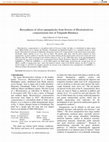
39-43Rhododenderon campanulatum is a decumbent shrub of Ericaceae family. In India, it is distrib... more 39-43Rhododenderon campanulatum is a decumbent shrub of Ericaceae family. In India, it is distributed (in alpine region from 3000m-3640m asl) in Jammu and Kashmir, Uttarakhand and Himachal Pradesh. It is commonly known as white burans. Phytochemical screening of methanolic and aqueous extract of R. Campanulatum reveals the presence of glycosides, flavonoids, tannin, saponin in, etc. It is toxic in nature. The present study deals with the green synthesis of silver nanoparticles. In green synthesis of Ag-NPs, the silver nitrate solution and the aqueous plant extract were mixed well in the different ratios.The metal ion present in the solution reduced as Ag+1 to Ag0 within three days. In the spectrophotometric observation the λmax peak of Ag-NPs of R. campanulatum flowers (RCF) obtained at 464nm for 1mM(RCF1:9), 492nm for 3mM(RCF1:9), 472nm for 5mM(RCF1:11). In the SEM analysis the SEM images reveled that the average grain size of 5RCF1:11AgNPs is ranging from 3μm - 4μm with spherical ...
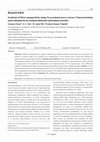
Asian Journal of Pharmacy and Pharmacology, 2018
Objective: Metallic nanoparticles are usually synthesized by chemical methods which require toxic... more Objective: Metallic nanoparticles are usually synthesized by chemical methods which require toxic chemicals. The objective of present study was to prepare silver nanoparticles of leaves extract and evaluated for Ficus palmata antimicrobial and antioxidant activities. In this current research article we report the eco-Materials and methods: friendly green synthesis of silver nanoparticles from leaf extract of without using any external reducing Ficus palmata or capping agent. The synthesized nanoparticles were characterized by UV-Vis Spectroscopy, X-ray diffraction (XRD), Scanning Electron Microscopy and Transmission Electron Microscopy (TEM) techniques. UV-Vis Results: Spectroscopy studies showed the absorbance peak at 452 nm. The XRD patterns indicated the formation of crystalline silver nanoparticles having face-centered cubic geometry. The spherical nature and size of synthesized nanoparticles was further confirmed by TEM. The synthesized nanoparticles showed considerable antibacterial and Conclusion: antioxidant activities.
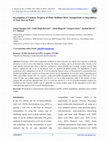
Journal of Mountain Research, 2021
Nowadays, silver nano-compounds mediated by plant materials are widely used material in daily lif... more Nowadays, silver nano-compounds mediated by plant materials are widely used material in daily life chemistry as well as across the industries, medical, electronics, ceramics, and in all research fields, because it has some specific characteristics such as non-toxic, inexpensive, nature-friendly, heat resistant, catalytic activity, high electric conductivity and so on. In the present work we reported the photo-catalytic dye degradation of green synthesized silver nanoparticles of size 43.75 nm by using the flowers extract of Rhododendron campanulatum tree. Synthesized AgNPs have worked as a strong nano-catalyst for the degradation of toxic dyes such as malachite green (MG), and acridine orange (AO). As a catalyst, synthesized AgNPs degraded the malachite green (MG) dye 47.22 % within 90 min, and acridine orange (AO) dye 66.16 % in 4 h of solar irradiation, while in the absence of nanocatalyst, MG and AO dye degraded upto 22.13 % in 90 min and 46.75 % in 4 h of photo-irradiation respe...
The Natural Products Journal, 2015
Flavour and Fragrance Journal, 2005
The root oil of Valeriana hardwickii var. arnottiana (Valerianaceae) collected from the Milam reg... more The root oil of Valeriana hardwickii var. arnottiana (Valerianaceae) collected from the Milam region of the Himalayas was analysed by GC–MS. Twenty-eight compounds were characterized, representing 92.1% of the total compounds detected. The essential oil showed a high content of oxygenated sesquiterpenes. The major constituents were valeracetate (17.3%), bornyl acetate (15.3%), methyl linoleate (11.7%), cuparene (10.4%) and α-cedrene (6.2%). Valeracetate was confirmed by 1H- and 13C-NMR data; it may be used as a chemical marker for this variety. Copyright © 2004 John Wiley & Sons, Ltd.










Uploads
Papers by Satish Chandra Sati